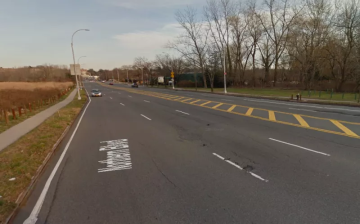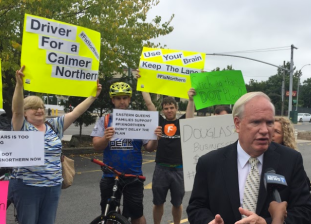DOT Stands Firm on Northern Boulevard Protected Bike Lane
Queens CB 11, which endorsed the bike lane in June, officially changed its mind on Monday. The city is going ahead with the project anyway.

In June, Queens Community Board 11 voted 18 to 11 to endorse DOT’s plan for traffic calming and a protected bike lane on Northern Boulevard near the Joe Michaels Mile bike path, where 78-year-old cyclist Michael Schenkman was struck and killed by a motorist last summer. Monday night, the board officially reversed its position, endorsing a less effective but more expensive proposal put forward over the summer by transportation co-chair Bernard Haber.
The city is standing firm, moving ahead with the project in the face of an escalating pressure campaign that has now roped in State Senator Tony Avella.
“DOT is open to continuing the discussion about board member Bernard Haber’s concept, however, DOT’s plan, which incorporated much of the Board’s previous feedback and received a vote of support this summer, allows the agency to immediately deliver critical safety benefits for the community and all street users,” the agency said in a statement.
The DOT project will repurpose one car travel lane to make room for a two-way bike lane protected from motor traffic by Jersey barriers. Haber wants to keep that space for motor vehicles. His idea is to put a shared biking and walking path on the sidewalk, which he believes could be expanded a few feet into the Alley Pond golf course.

When Haber floated his concept in June, DOT reps told him it would be costly and complicated, requiring approval from multiple agencies and an expensive capital construction project, which would take years to complete. At Monday’s CB 11 meeting, DOT’s Ted Wright estimated it would cost $10 million dollars and take five years, according to audio of the meeting obtained by Streetsblog.
Haber, with assistance from board chair Christine Haider, worked over the summer to get CB 11 to reverse its earlier vote. He prevailed on the transportation committee to endorse sending a letter to DOT suggesting an open mind on his plan.
The letter that Haider sent went far beyond what the committee agreed to, arguing that the June vote was illegitimate because of “poor” process. “We cannot accept the permanent reduction in the westbound truck and passenger vehicle lanes on Northern Boulevard,” she wrote [PDF].
On Monday, Haider said she and Haber met in August with State Senator Tony Avella, who spoke on their behalf with DOT Commissioner Polly Trottenberg.
The scheme to rescind the June resolution and replace it with an endorsement of Haber’s proposal was not announced before the meeting.
“This is not a plan, this is the status quo. You know that the present situation is incredibly dangerous, this will not change anything,” board member John Kelly told his colleagues. “There is one answer on the table that’s doable, that’s quick, and that DOT has said ‘we can do.'”
The board approved the sidewalk “plan” by a vote of 29 to 5.



